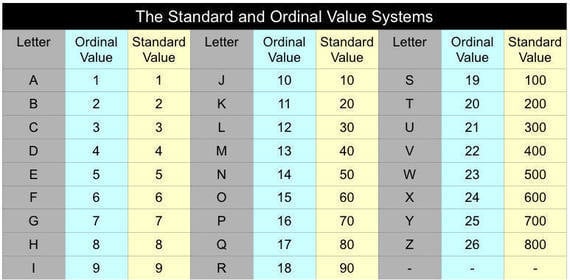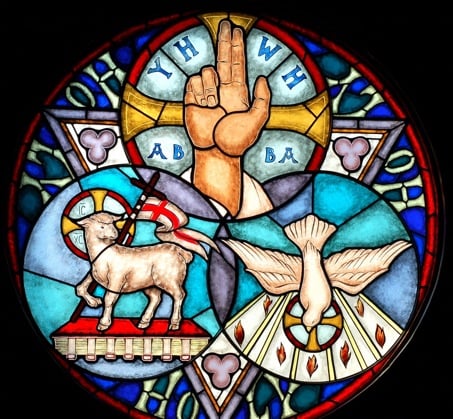The Two-part Decoding System
The New Bible Code is an alphanumerical code with a vital message for us all, centred within the text of the English language NIV Bible (1984 edition), but also enfolded within 9/11, other world-viewed events, western culture and more. The code utilises the principles of gematria, whereby words, phrases and passages of biblical text have been encoded with numbers in order to insert a deeper layer of meaning into them. Gematria includes the use of simple geometric forms and other mathematical ideas, and reflects and extends the traditional meanings of biblical numbers.
Numeration Systems and the Two-Part Decoding Method
Unique to the New Bible Code is a two-part decoding method, based on two systems of converting letters into numbers. These are the ordinal value system, which is the replacement of a letter by its position in the alphabet (the simplest system of all), and what I call the standard value system, the English equivalent of the long-established Hebrew scheme of alphabetic numeration. The two schemes are tabulated below.

Under such systems, words are converted to numbers by replacing each letter by its numerical value, then summing these numbers to give a total for the word, and by extension phrases and passages of text. For example, the word 'God' can be converted to numbers under the ordinal value system (o) and the standard value system (s) as shown:
God (o) = 7 + 15 + 4 = 26
God (s) = 7 + 60 + 4 = 71.
So the ordinal value of 'God' is 26 and the standard value is 71.
In the New Bible Code these two systems work together as follows:
1. Passages of text are converted to numbers using the ordinal value system.
2. These numbers convey meaning under the standard value system by conversion into words and phrases. Through numerical geometry they may also represent regular geometric objects.
This two-stage decoding process was given to me in a miraculous way as a key, which showed me how to unlock the bulk of the information contained in the NIV Bible. [1] I wasn't given the key until November 2001, which ensured that the code remained hidden until a certain world event (9/11) had taken place. [2]
An Example
An example will make the efficacy of this system stunningly clear, and also afford you a first glimpse of a tiny part the code.
The first twelve words of the NIV Bible are as follows:
In the beginning God created the heavens and the earth. Now the . . .
If we now calculate the ordinal value (o), ie the sum of the ordinal values of each individual letter, we find it is 515. Or more formally,
Words 1 to 12 of Genesis (o) = 515
This is the standard value (s) of the name sacred to all Christians:
Jesus (s) = 515
All this information can be displayed more visually in a table:

I'd like to point out a few details here, so you can appreciate the full significance of this and other findings.
Firstly, where better to place this number? The Bible is the world's best-selling and most influential book, claiming to be God's revelation to man. The NIV Bible itself is now the most popular English translation (it now outsells the KJV Bible), and English is the international language of choice. These are the first, and most high profile words in scripture. If God wished to place His mark somewhere, then this would be the book, version, language and precise location for it.
Next, who better to begin with? The Bible itself is the epic story of our troubled relationship with God, and our final reconciliation with Him through the work of atonement performed by his Son. A word other than 'Jesus' could have been used, of course. In fact there are over seventy words used to refer to God's Son in scripture. But the name at the top of any such list of words would always be 'Jesus'.
On a more technical level, this little word string contains twelve words and in the Bible the number twelve signifies perfect government, which is why there were twelve tribes of Israel and why Jesus had twelve disciples.
Finally, this is the sum of the first twelve words, not twelve words buried somewhere in the middle of a chapter. Finding a desired number within the text is not particularly difficult. The odds of hitting a particular number by chance as you move along a word string are only about 1 in 50, about the same as drawing the ace of spades from a randomly shuffled pack. But if we miss the number we seek as we sum from word 1, we can start again from word 2, then from word 3, etc. In fact, we would expect to find 515 somewhere within the first few verses, just as we would expect to eventually draw the ace of spades from that pack of cards after thirty shots or so. But finding such a significant number on the first shot is a different matter. Finding 'hot' numbers that begin books, chapters and verses, or are the ordinal values of entire verses, is always vastly less probable than finding them somewhere in the Bible - that is inevitable. But we should normally expect to find such numbers in obscure word strings, not in high-profile locations or in locations that are meaningfully related to that number through its place value in the Bible or the plaintext words. Yet these are regular features of the New Bible Code.
Bill Downie 6/12/15
Notes
1. In fact, the entire process was guided by an unseen hand, which (literally) handed me the NIV Bible for decoding and pointed out the exact location of the watermark.
2. The two-part decoding method also has the advantage of reducing any possible bleed-through of information from the plaintext words to the cypher text, because words and phrases with the same value under one system will normally have a different value under the other system.
